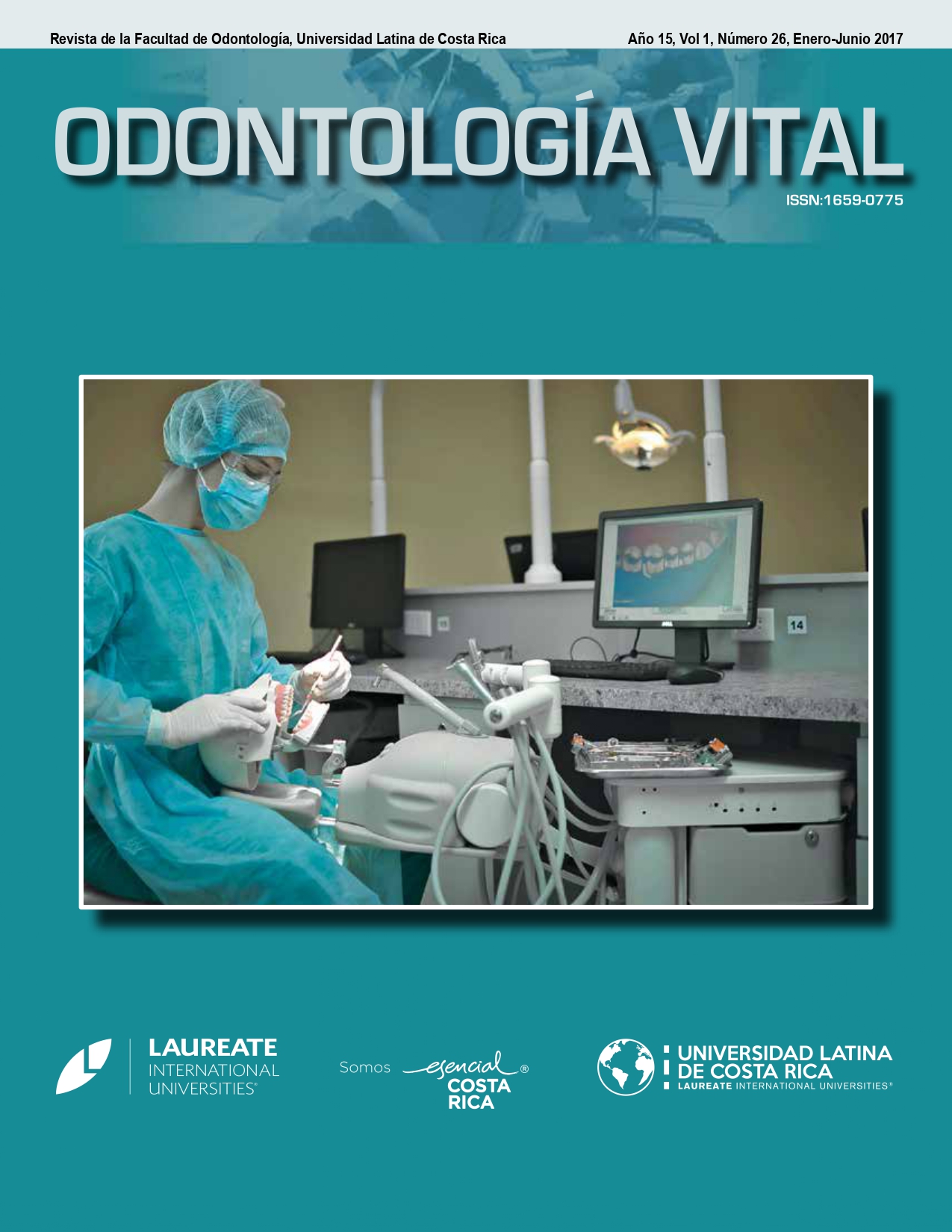Behavior and perception of pain in colombian children under surface electromyography
Based on the research: “Behavior and perception of pain in children with and without cleft lip and palate who underwent evaluation of perioral and masticatory muscles with the electromyography surface technique”
DOI:
https://doi.org/10.59334/ROV.v1i26.220Keywords:
Surface electromyography, pain, behavior, cleft lip and palateAbstract
The Surface electromyography–EMG evaluates muscular function. It is seldom used as a routine examination to assess perioral and masticatory muscles as it is considered to cause the pediatric patient discomfort.
Objective: Describe the perception of pain and behavior displayed by Colombian children with and without cleft lip and palate during the surface electromyography test performed on perioral and masticatory muscles.
Methods: Prior approval by the ethics committee (act-009-2013p) and an informed consent and assent signature were obtained. The exam were performed on 69 children between 5 and 15 years; 45 with cleft lip and palate (23 with unilateral cleft, 22 with bilateral cleft) and 24 children without cleft. The Wong Baker (pain) and Frankl (behavior) scales were used.
Results: At the beginning of the exam, 66 children (95.66 %) displayed type 4 behavior and 3 children (4.35 %) displayed type 3 behavior. At the end of the procedure, 100 % of the children displayed type 4 behavior. When using the Wong Baker scale, the perception of the pain showed that 62 patients (89.86 %) felt no pain and 7 patients (10.14 %) felt just a little pain.
Conclusions: Children do not show significant changes in their behavior - or pain and discomfort during the procedure of surface electromyography.
Downloads
References
American Academy of Pediatric Dentistry. (2011). Guideline on Behavior Guidance for the Pediatric Dental Patient. Reference Manual, 36(6), 180-93
Essick, G. K., Dorion, C., Rumley, S., Rogers, L., & al, e. (2005). Report of altered sensation in patients with cleft lip. The Cleft Palate - Craniofacial Journal, 42(2), 178-84. https://doi.org/10.1597/03-124.1
Essick, Greg,D.D.S., PhD., Phillips, Ceib,M.P.H., PhD., Chung, Y., M.S., & Trotman, Carroll-Ann, BDS,M.A., M.S. (2013). Effects of lip revision surgery on long-term orosensory function in patients with cleft Lip/Palate. The Cleft Palate - Craniofacial Journal, 50(5), 507-12. https://doi.org/10.1597/11-247
Genaro, K. F., Trindade Júnior, ,A.S., & Trindade, I. E. (1994). Electromyographic analysis of lip muscle function in operated cleft subjects. The Cleft Palate-Craniofacial Journal : Official Publication of the American Cleft Palate-Craniofacial Association, 31(1), 56-60. https://doi.org/10.1597/1545-1569_1994_031_0056_eaolmf_2.3.co_2
Jylli, L., & Olsson, G. L. (1995). Procedural pain in a paediatric surgical emergency unit. Acta Paediatrica (Oslo, Norway : 1992), 84(12), 1403-1408. https://doi.org/10.1111/j.1651-2227.1995.tb13577.x
Li, W., Lin, J., & Fu, M. (1998). Electromyographic investigation of masticatory muscles in unilateral cleft lip and palate patients with anterior crossbite. The Cleft Palate-Craniofacial Journal : Official Publication of the American Cleft Palate-Craniofacial Association, 35(5), 415-418. https://doi.org/10.1597/1545-1569_1998_035_0415_eiommi_2.3.co_2
Massó, N., Rey, F., Romero, D., Gual, G., Costa, L., & Germán, A. (2010). Aplicaciones de la electromiografía de superficie en el deporte. Apunts Med Esport, 45 (165), 127-36. https://doi.org/10.1016/j.apunts.2010.02.005
Posnick, J. C., al-Qattan, M., Pron, G. E., & Grossman, J. A. (1994). Facial sensibility in adolescents born with cleft lip after undergoing repair in infancy. Plastic and Reconstructive Surgery, 93(4), 682-5
Susami, T., Kamiyama, H., Uji, M., Motohashi, N., & Kuroda, T. (1993). Quantitative evaluation of the shape and the elasticity of repaired cleft lip. The Cleft Palate-Craniofacial Journal : Official Publication of the American Cleft Palate-Craniofacial Association, 30(3), 309-312. https://doi.org/10.1597/1545-1569_1993_030_0309_qeotsa_2.3.co_2
Tecco, S., Tetè, D’attilio, M., Perillo, L., & Festa, F. (2008). Surface electromyographic patterns of masticatory, neck, and trunk muscles in temporomandibular joint dysfunction patients undergoing anterior repositioning splint therapy. European Journal of Orthodontics, 30(6), 592-7. https://doi.org/10.1093/ejo/cjn052
von Baeyer, C.,L. (2006). Children’s self-reports of pain intensity: Scale selection, limitations and interpretation. Pain Research & Management : The Journal of the Canadian Pain Society, 11(3), 157-62. https://doi.org/10.1155/2006/197616
Walco, GA., Conte, PM., Labay, LE., Engel, R., & Zelter, LK. (2005). Procedural distress in children with cancer. Self-Report, Behavioral Observations, and Physiological Parameters. Clin J Pain, 21(6), 484–90.
Wong, DL & Baker CM. (1988). Pain in children/ comparison of assessment scales. Pediatr Nurs, 14(1),9-17
Wright G, Stigers J. (2011). Nonpharmacologic Management of children´s behaviors. In Dean, J., Avery, D., & Mc-Donald, R., Dentistry for the Child and Adolescent (9th ed. p 27-40), Maryland, Missouri: Mosby Elsevier
Zarante, I., Franco, L., López, C., Fernández, N. (2010). Frecuencia de malformaciones congénitas: Evaluación y pronóstico de 52.744 nacimientos en tres ciudades colombianas. Biomédica, 30(1), 65-71.
Downloads
Published
Issue
Section
License
Copyright (c) 2017 Andrea Rivera, María Clara González

This work is licensed under a Creative Commons Attribution 4.0 International License.
Authors who publish with Odontología Vital agree to the following terms:
- Authors retain the copyright and grant Universidad Latina de Costa Rica the right of first publication, with the work simultaneously licensed under a Creative Commons Attribution 4.0 International license (CC BY 4.0) that allows others to share the work with an acknowledgement of the work's authorship and initial publication in this journal.
- Authors are able to enter into separate, additional contractual arrangements for the non-exclusive distribution of the Odontología Vital's published version of the work (e.g., post it to an institutional repository or publish it in a book), with an acknowledgement of its initial publication.
- Authors are permitted and encouraged to post their work online (e.g., in institutional repositories or on their website) prior to and during the submission process, as it can lead to productive exchanges, as well as earlier and greater citation of published work.







